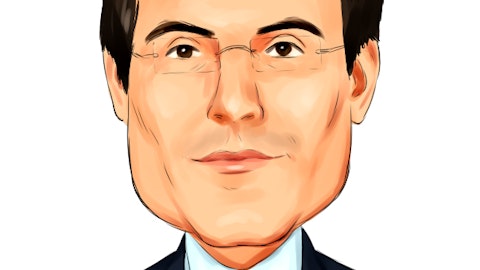Douglas Schenkel: Thanks, great to be back. And working with great focus like you and the team. So I want to start just with a high-level LRP question, and then my follow-up is really just a clarification on LPS. So on the LRP, Marc, you’ve been consistent in saying that Thermo is built to grow two to three points better than the peer group over the long term. That said, you did talk about 7% to 9% growth as recently as last year’s Analyst Day. I’m sure the two to three points hasn’t changed. But as we flip the calendar, is it fair to say that the 7% to 9% growth rate maybe is a little bit high, even in a more normalized environment, I just want to give you an opportunity to maybe just adjust that as we kind of flip the calendar and look ahead?
And below the top line, you’ve done a fantastic job, as always, leaning operations in a more challenging period. Never let a good crisis go to waste. Your guidance suggests to me, at least on the surface, that you may be investing more in the near term. But as we think about a return to normal, I’m just wondering if you think we could get some outsized incremental margin flow-through for the business as the business normalizes? So let me leave it there, and then I’ll ask a quick follow-up on LPS in a second.
Marc N. Casper: Sure. So Doug, thanks for the question. In terms of the long-range outlook, right, we raised our outlook in late in 2021. And what that — at that moment, we can’t remember exactly what that moment was, but we were growing 25%, right. We were growing at an extraordinary organic rate. And what we wanted to do was give our investors a very long-term view of what is the market and what is our position in the market, right. And in terms of our ability to gain share, three points, I think — two, three, I use three for simplicity. Three points faster than the market is kind of the standard we hold ourselves to. And we’ve been delivering that for a while, and we’ve been growing share for a really long while for many, many, many years.
And so nothing has changed there. In terms of the market growth, where the market was extraordinary when we set it, we said 4% to 6% was going to be our underlying market growth, and that was higher than 3% to 5%. And the change was actually just that we had a larger exposure to pharma and biotech as we built our business capability there. When I look to the future and I think about what’s going on in the drivers of the long term in our industry, I feel incredibly confident that this is a 4% to 6% growth industry and that we’re well positioned to grow, for simplicity, three points faster than that, so 7% to 9%. So while I get the question a lot and obviously, in a period where we delivered 1% core growth in 2023, that’s a long way from 7% to 9%.
But our view on the market declining low single digits last year reflects at least a share gain component. And when I look to the future, I continue to remain very confident in the long-term health of the industry. I’ve had some really interesting discussions with investors and basically went through the logic saying, if you’re bullish on life science tools, diagnostics, pharma services, you’re probably at 6% long-term growth. And if you’re bearish on the life science tools, diagnostics and pharma services, you’re probably at 4% industry growth. But you have to be incredibly bearish on the world to actually get to less than 4% industry growth for the long term in our segment because this — we really are a GDP-plus-type business in terms of the markets that we serve.
So hopefully, that gives you at least a sense of how we think about it and while I appreciate the offer to change our outlook, I couldn’t be more confident in the future of our industry and our competitive position. In terms of the below the line, the very high-level concept, I do believe that as you see volumes grow at more normalized rate, you’ll see a very strong flow-through on the margins. And part of what’s going on with the margins for this year is we reset our incentive compensation for our colleagues back to normalized levels after a year of below that. So just the math as you have some level of headwind embedded in the easier numbers, nothing different than we expected in October. But that’s part of why you don’t see as much of the margin step-up that one would expect to have.
Douglas Schenkel: Okay. I’m going to — I’ll leave the LPS question for another day. But I guess, the other part of my question on the margins, Marc was obviously, you got to pay people, you got to reset things. In a period where you’re not growing as much, this is where Thermo has historically played offense while others have played defense to a certain extent. So I’m just wondering if you’re actually pulling forward some investment early in the year and that could over the next several quarters lead to even better-than-expected margin flow-through as the company returns to a more normalized period.
Stephen Williamson: Yes. Doug, I think the example that I gave on the GLP-1 contract is we’re basically standing up a facility for a customer. We’re getting paid a fee to do that. We get to recognize that fee over the production volumes, and we’re incurring substantial costs in the interim in 2024, which will create good accretive growth going forward. That’s one good example. And we’re continuing to invest in innovation across the company. And we’re not lessening our drive here to really drive great long-term growth. So we’re appropriately managing our cost, top line environment, but we’re making sure that we’re actually putting the right investments in place and to make sure that, that top line environment stays and the outlook stays as good as we — as much as articulated.





